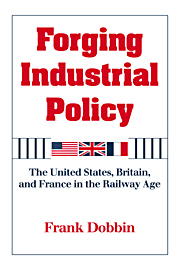5 - Conclusion
Published online by Cambridge University Press: 05 June 2012
Summary
Introduction
My point of departure was the observation that by the beginning of the twentieth century the United States, France, and Britain had developed dramatically different strategies for promoting industrial growth that have since survived tremendous political changes. The parallels between these nations' modern industrial policy paradigms and their traditional paradigms of political order are striking. Most analysts have taken parallels between nations' political and economic systems for granted by using sweeping terms such as laissez-faire, liberalism, statism, and authoritarianism to characterize both systems at once. My aim has been to problematize these parallels and to suggest that comprehending them is the key to grasping why cross-national policy differences persist. I have tried to discover how industrial cultures came to resemble political cultures by studying how early nineteenth-century state institutions influenced the subsequent development of railway policy. I do not suggest that the industrial policy paradigms that emerged in these countries were overdetermined by political culture – indeed, the United States' earliest industrial policy paradigm was rejected and replaced during the nineteenth century. Rather, I have argued that by designating certain social processes as constitutive of order and others as destructive of order, institutionalized political culture shaped the kinds of industrial practices nations would try to create, and the kinds they would try to prevent. That is, by symbolizing certain means-ends relationships in social life, political culture shaped the means nations would conceive to the ends of industrial organization and growth.
- Type
- Chapter
- Information
- Forging Industrial PolicyThe United States, Britain, and France in the Railway Age, pp. 213 - 232Publisher: Cambridge University PressPrint publication year: 1994

